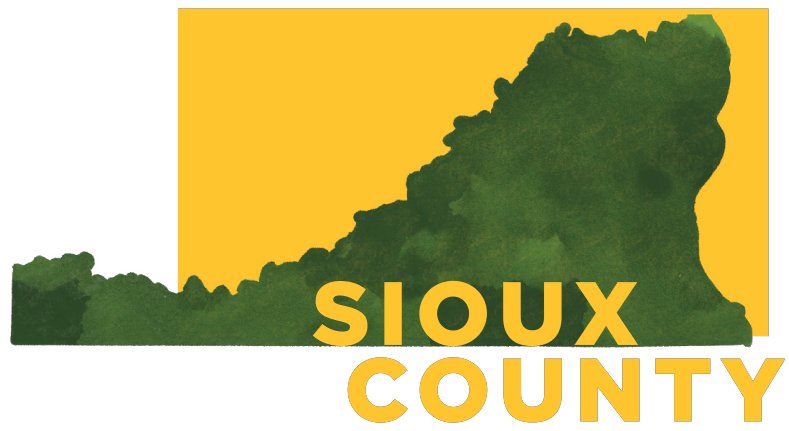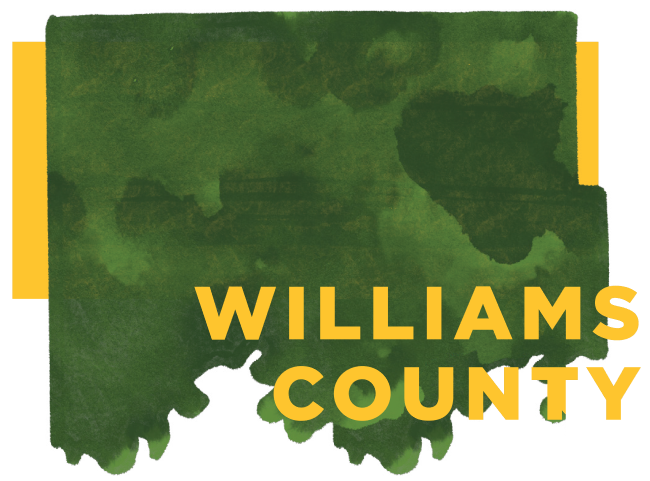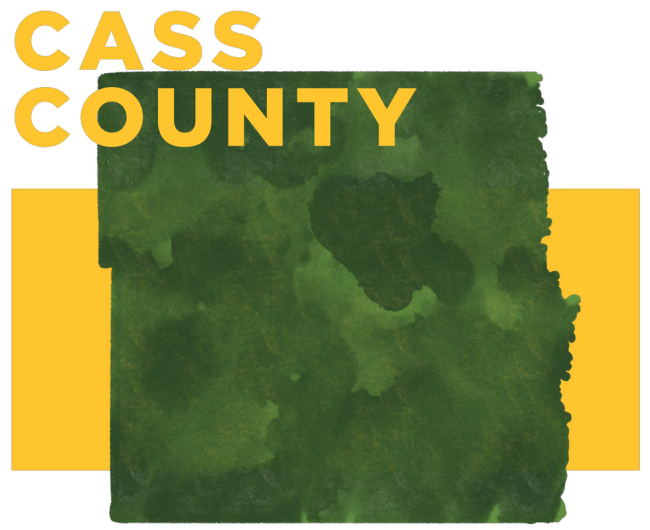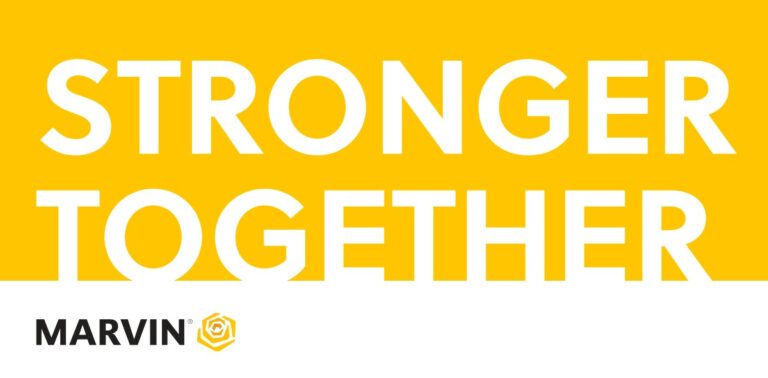Marvin’s partnership with NDSU is a testament to the power of community, innovation, and the belief that anything is possible.
Read MoreBringing the University to the People
NDSU Extension serves North Dakotans through 53 county offices. Programming is widespread and nuanced to meet the needs of citizens. Visit three county offices to see Extension's mission at work.
Story by Nicole Thom-Arens | Illustrations by Leah Ecklund | March 21, 2023

On a mid-January morning in 2023, I drove south from Mandan, North Dakota, to Solen, North Dakota, a community located in north-central Sioux County — about 15 miles west of Cannon Ball, North Dakota. The flat prairies of the eastern part of the state gave way to rolling, snow-covered hills. The day’s fog hadn’t yet set in, and while I met several cars that were heading north, none were ahead of or behind me. For 42 miles, I happened only upon the occasional cattle ranch.
“It’s beautiful and peaceful here, but there’s no extra activities for our children to do,” Tomi Phillips, Solen School District superintendent, said.
While 42 miles doesn’t sound like a far distance, without transportation — one of the county’s greatest challenges — there might as well be a chasm separating Standing Rock Reservation and Bismarck-Mandan, which has the closest movie theater, bowling alley, or full supermarket. That’s the isolation Tomi describes for the students in her community.

Standing Rock also faces challenges related to poverty, high unemployment, low graduation rates, housing shortages, and lack of fertile soil. When the Oahe Dam was constructed north of Pierre, South Dakota, in 1960, flooding from the dam forced Standing Rock families to evacuate their homes along the Missouri River valley. The flooding washed away fertile soil, making it impossible to grow food, which led to health consequences for the people living there.
Tomi grew up in and graduated high school from Standing Rock — she’s an enrolled tribal member. She’s a former Bush Fellow, earned her master’s degree and her Doctor of Education, and returned to Standing Rock because it’s home. She knows well the challenges facing her community and what programming will work to bring positive changes.
“We want people to come work with us, work with our children, and see the beauty and their strengths. We don’t need somebody to come in here and save us,” Tomi said. “If people are truly looking to our future, students — our children — are our future, so they need to be supported. Programs like Sue’s benefit students — especially those who come from a lower socioeconomic status.”
When she speaks of NDSU Extension agent Sue Isbell, Tomi calls Sue an ally.
“Sue is able to offer a lot of different opportunities to get students exposed to life outside of their local community,” Tomi said. “She knows the families, she knows the students, she knows the demographics. She fits right in.”
As the 4-H and youth development agent for Sioux County, Sue provides mentoring and educational programs for local youth. She has been working with educational programs through NDSU Extension since 2003 and became the full-time agent in Sioux County in 2005. In the past, she received a grant to construct raised gardens across the county to address lack of access to fresh food. Today, Sue primarily works with students at Solen High School. During my visit, Sue struck up conversation with every student she passed in the hall. She talked about the rival basketball team’s loss the night before. Noticing one girl was having a tough day, Sue invited her to come visit later in the day. As we passed through the gymnasium, Sue yelled, “Nice shot!” after a boy nailed a three-pointer. Sue’s knowledge of local needs, as well as the students themselves, allows her to focus on bringing sustainable programming to the students.
"Extension programs are based on current issues and needs identified by stakeholders at the local, state, and national levels."
Lynette Flage
Sue was instrumental in starting Sioux Image, a local print shop, with a national 4-H mentoring grant. Since the shop opened in 2010, students have been learning commercial machine needle embroidery, laser and vinyl cutting, six color screen printing, jewelry making, and ceramics. Students sometimes create their own artwork for clothing, mugs, and decorative pieces. They open the Sioux Shop during home basketball games and sell their creations. Artwork from Butch Thunder Hawk adorns the Sioux Shop’s walls. He’s given permission to Sioux Image to print his designs without asking for royalties in return. All the money made through the Sioux Shop’s sales goes back into the Sioux Image business to help youth learn about the various responsibilities involved in business management.
Additional NDSU Extension programming in Sioux County includes robotics, coding, and drone flying, and this spring, they’ll hatch chicks. Sue focuses heavily on science and uses evidence-based curriculum provided by NDSU Extension youth development researchers. NDSU Extension looks a little different in every North Dakota county because it is tailored to the needs of the community.
“When people ask me who I work for, I’m employed by NDSU Extension, but I work for the people of Standing Rock; you work for the people you serve,” Sue said. “Extension isn’t in a silo; it is part of the community and it’s a partnership. My programs are successful because of everyone else. We all work together. That’s something that’s extremely unique down here. It’s engrained in the community.”
That partnership and trust among community members is what makes NDSU Extension programming work across North Dakota. NDSU Extension has agents stationed in each of North Dakota’s 53 counties and all of the state’s U.S. Indian Reservations.
“Staff in county Extension offices and Research Extension Centers across the state complete the link between campus and North Dakota citizens,” Lynette Flage ’04, ’10, associate director of NDSU Extension, said. “Extension programs are based on current issues and needs identified by stakeholders at the local, state, and national levels.”
Since 1914, NDSU Extension has been bringing the University to the people. Today, programming targets three major program areas: agriculture and natural resources, family and community wellness, and 4-H youth development.
“The research that happens on the NDSU campus by faculty researchers and at the seven Research Extension Centers positioned across the state is transferred to the farmer, rancher, parent, community member, or young person so they can use that information effectively for themselves,” Lynette said. “NDSU Extension specialists develop resources and programs so the information can be creatively delivered to communities through our agents who are living and working in each county. Our staff are trusted and respected, and our clientele know that unbiased, research-based information is coming from the University to them. We like to think of it as having NDSU in more than 53 locations besides the Fargo campus.”

Kelly Leo, NDSU Extension agriculture and natural resources agent in Williams County, has been serving her community for nearly three years. She has revolutionized the 4-H volunteer network in the county.
“Our focus has shifted from our needs to understanding more about the needs of our youth and volunteers. That’s been a big change,” Kelly said. “Letting them know that it’s OK to develop ideas and lead has been the biggest change.”
Kelly implemented 4-H volunteer trainings and launched new 4-H programs based on community need — like the dog program where kids work with their pets on obedience and get them prepared for dog shows. Volunteer participation increased from 15 to 20 during Kelly’s first year to about 80 volunteers in 2022.
Williams County, located in northwestern North Dakota, shares a border with Montana. It is a strong agricultural community with rich natural resources — about 15 different commodities are grown in the county. Williams County is also home to the Williston Research Extension Center, which is part of the North Dakota Agricultural Experiment Station, and is where scientists evaluate crop varieties, pesticide performance, cropping and livestock systems, soil health, and natural resource conservation practices. Kelly often partners with the Williston Research Extension Center for programming and frequently holds her programs at the center. For the past two summers, particularly in 2021, Kelly spent many hours in the field working with local ranchers.
“We’ve done a lot of training and information sharing on responses to the drought — things like water quality testing for livestock,” Kelly said. “There were many poor water sources in 2021, which was an epic year for drought in the western part of the state. We experienced quite a few cattle deaths from that. I was in the field four to five days a week just pulling water samples for folks.”
By testing the water, it was estimated that more than 40,000 head of livestock statewide were saved because of the NDSU Extension education related to the high levels of sulfate and what that toxicity meant for cattle. Because of this information, ranchers were encouraged to find new, safe water sources.
North Dakotans are probably most familiar with Extension programming related to agriculture and 4-H, but NDSU Extension also offers programming related to family and community wellness. These agents offer programs on topics like food, nutrition and health, healthy aging, leadership and civic engagement, personal and family finance, and parent and family education.
Most counties have both an agriculture and natural resources and family and community wellness agent. Williams County has agents in both areas, and the county has funded a third position, a parent educator, who teaches parent classes, leads training for childcare providers, and works to support parents and families throughout life’s transitions.
"Our focus has shifted from our needs to understanding more about the needs of our youth and volunteers. That's been a big change."
Kelly Leo
Extension’s work is possible across the state because of multiple funding sources. The organization receives federal, state, county, and grant funds.
NDSU Extension’s partnership with counties is critical to its success. Each county pays half the salary of each agent in addition to operating costs including travel and office space. NDSU Extension pays the remaining salary and covers 100% of the employee’s benefit package. Extension offices in larger counties across the state usually employ numerous agents who deliver more focused programming.
“We appreciate the individuals and organizations that contribute to Extension programs as it allows us to continue our innovative and impactful work for North Dakota,” Lynette said.
Private support through philanthropy enhances Extension programming. Benefactors have supported scholarships and fellowships, research, equipment, 4-H youth development, and staff professional development programs for Extension. Since 2016, benefactors have invested more than $3.2 million in NDSU Extension.

Cass County, North Dakota’s largest and most urban county, has eight agents, one that focuses on each of the following areas: agriculture and natural resources; 4-H youth development; family nutrition; parent education; horticulture; expanded food and nutrition education; family and community wellness; and leadership and civic engagement. The NDSU Extension office in Cass County serves about 25% of North Dakota’s entire population.
“With such a diverse population, reaching the population is an interesting challenge,” Don Kinzler ’79, Extension’s horticulture agent in Cass County, said. “That’s why we use many media outlets to market our programs, including print, TV, radio, and social media.”
Don writes a weekly column for the Fargo Forum and he and Rita Ussatis ’84, ’92, the family and community wellness agent in Cass County, alternate monthly appearances on North Dakota Today, a morning show broadcast on KVLY. In such a large, urban community, Extension programming looks different than it does across much of the state, but its value is just as great.
“There’s so much information online that isn’t accurate that it’s almost dangerous,” Don said.
Rita recounted a time she had to tell someone to discard 80 quarts of pickles because they had followed YouTube video instructions and the pickles were molding. She is sympathetic to the food waste and the money and time invested but reiterates the importance of accurate information for where people live.
“We provide local, research-based information for our area that we know is current and based on the latest information from the USDA,” Rita said. “Food preservation in Florida is different than it is in North Dakota, and it is different in Williston than it is in Fargo because processing times are determined by elevation.”
Serving such a large population means agents in Cass County are often at the forefront of providing programs based on local needs. The agents often collaborate with each other and local partners to bring programs to diverse audiences, including low-income individuals, people with disabilities, and new Americans.
"Extension has remained relevant because we change with the times. The programs we do today continue to evolve based on needs."
Lynette Flage
“Another thing that makes us unique is that we all program with each other. Multiple agents go out and teach whether in the classroom for a living ag program or at the fair,” Rita said. “We’re all working together trying to expand everyone’s programming and making sure we’re all helping everybody.”
Since the pandemic, many classes have been offered virtually via Zoom, which has increased reach and number of participants. Don also leads gardening programs virtually and has seen participation double. Other programs are more intensive. The Diabetes Prevention Program, for example, is a year-long program and involves 24 lessons.
“I tried many different programs over the years, and they were not sustainable,” Tami Stillwell, a Cass County Diabetes Prevention Program participant, said. “What I learned in this program was to deal with real foods, portioning, watching your fat grams, and exercising more — the keys to having a healthy lifestyle.”
Tami’s doctor recommended the program to her when she was pre-diabetic and taking medication. She’s lost weight and is now off that medication.
“I’m learning how to cope with things differently and in a healthier way,” Tami said. “This program has been very successful for me in a real way.”
NDSU Extension, across all 53 counties, brings evidence-based information to the people and puts the decision making into the hands of the farmer, rancher, or community member without a sale or exchange of goods, and people trust and appreciate that.
Farmer and rancher stress, mental health, food security, workforce development, and research and education around precision technologies are examples of community concerns that were less prevalent 20 to 30 years ago and are now opportunities for Extension programming.
“We continue to look at the big issues affecting the state, our country, and the world on a regular basis,” Lynette said. “We then complete research on those issues and deliver the education to help resolve the challenges that we face. Extension has remained relevant because we change with the times. The programs we do today continue to evolve based on needs.”
To support NDSU Extension programming, visit the NDSU Extension giving page.
Share This Story
Related Stories
Success: A Team Project
With support, Caryn Marty ’26 is empowered to say “yes” to all the possibilities NDSU has to offer.
Read More
